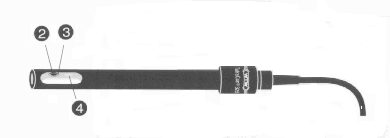|

9. A DETERMINATION OF THE CONDUCTIVITY
OF A WATER SAMPLE AND AN ESTIMATION
OF
THE TOTAL DISSOLVED SOLIDS (TDS)
9.1 Objective
Determine the electrical conductivity
of a water sample and estimate the total
dissolved solids (TDS).
9.2 Background
The measuring system consists
of a conductometric probe with an incorporated
temperature sensor (4) and a portable conductivity
meter. The conductometric probe is
illustrated in the picture below. A pair
of voltaic (2) and electric current (3 –
ring shape) electrodes is clearly marked.

Conductance is the reciprocal of resistance.
The measuring unit is Siemens (S), which
equals 1/Ω. The measurement results are
expressed as conductivity in S/cm at the reference temperature;
this makes the results obtained with probes
of different geometries and under different
conditions comparable.
A determination of a solution’s conductivity
provides a first indication of the concentration
of electrolytes dissolved in the sample
solution. The term total dissolved solids
(TDS) is used in water analysis. A higher
conductivity is related to a higher concentration
of TDS in the water.
TDS = f · conductivity
For natural waters the proportional factor
f is expected to be in the range 0.55–0.76,
depending on the type of water sample. The
selected proportional factor is already
in the memory of the conductivity meter;
therefore, the amount of TDS is readable
directly from the screen of the conductivity
meter.
Note.
A measurement of a solution’s
conductivity gives only an estimation of
the TDS. The exact value for the TDS is
obtained from a complete analysis of a water
sample, and is the sum of the mass concentrations
of all the anions, cations and weak electrolytes,
but not gases, expressed in mg/L.
9.3 Equipment and reagents
- A WTW LF 323/325 portable conductivity
meter.
9.4 Procedure*
Press the κ button to select the
measurement of conductivity (µS/cm).
Immerse the conductometric probe in the
sample solution. Start the measurement by
pressing the RUN button. Press the
κ button to access the TDS reading.
Rinse and dry the probe after the measuring
process.
* For other instruments
follow the instructions of the producer.
?
?
Under the serial number of the sample write the conductivity and the
TDS in the table “Basic
data on water samples”.
The guide value for conductivity in drinking
water which is set by the EU Drinking Water
Directive (Council Directive 98/83/EC) is
2500 µS/cm at 20 ºC.
|
